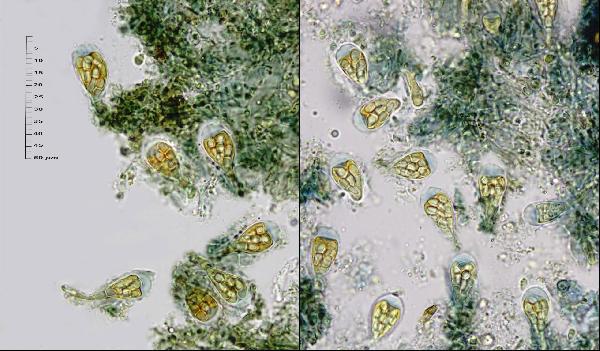Arthonia didyma Körb.
Denkschr. schles. Ges. vaterl. Kultur: 235, 1853.
Synonyms: Arthonia aspersella Leight.; Arthonia atrofuscella Nyl.; Arthonia pineti Körb.; Arthonia sapineti Nyl.; Caldesia didyma (Körb.) Trevis.
Description: Thallus crustose, mostly endosubstratic and inconspicuous, pale brown or olive-grey, sometimes with a pink hue when fresh. Apothecia arthonioid, emarginate, more or less immersed, rounded, shortly ellipsoid or weakly and irregularly lobed, 0.1-0.5 mm wide, 45-100 μm tall, with a dark brown to brown-black, epruinose, mostly flat disc. Epithecium yellowish brown to reddish-brown, c. 5 μm high, K+ purple-violet or K-, the pigments dissolving; hymenium colourless to spottily pale orange-brown, the pigmented parts K+ purple-violet or K-, 33-50 μm high; paraphysoids 0.5-1.5 μm thick, brown-walled, the apical cells to 2.5 μm wide; hypothecium red-brown, 5-30 μm high, the pigment K+ grey or olive. Asci 8-spored, subglobose, semi-fissitunicate, with a large apical dome and a distinct ocular chamber, Arthonia-type. Ascospores 1-septate and slightly constricted at septum, with subequal to unequal cells ovoid,, at first hyaline and smooth, later brownish and warted, (12-)14-18 x (4-)5-8 μm, thick-walled, but without a gelatinous sheath. Pycnidia rare, immersed, the wall red-brown, K+ olive-grey. Conidia bacilliform, 3.5-4 x c. 0.7 μm. Photobiont trentepohlioid. Spot tests: K-, C-, KC-, P-. Chemistry: thallus without lichen substances; anthraquinones often (but not always) present in pigmented parts of the apothecia.
Growth form: Crustose
Substrata: bark
Photobiont: Trentepohlia
Reproductive strategy: mainly sexual
Most common in areas with a humid-warm climate (e.g. most of Tyrrenian Italy)
Commonnes-rarity: (info)
Alpine belt: absent
Subalpine belt: absent
Montane belt: rather rare
Dry submediterranean belt: extremely rare
Humid submediterranean belt: extremely rare
Padanian area: absent
pH of the substrata:
1 2 3 4 5
Solar irradiation:
1 2 3 4 5
Aridity:
1 2 3 4 5
Eutrophication:
1 2 3 4 5
Poleotolerance:
0 1 2 3
Altitudinal distribution:
1 2 3 4 5 6
Rarity
absent
extremely rare
very rare
rare
rather rare
rather common
common
very common
extremely common
Loading data...
Occurrence data
Predictive map

Felix Schumm – CC BY-SA 4.0
[14965], Germany, Baden-Württemberg, Kreis Tübingen, zwischen Dettenhausen und Bebenhausen, bei der Bärlochhütte im schattigen Buchenwald, 450 m

Felix Schumm – CC BY-SA 4.0
[19622], Germany, Baden-Württemberg, Kreis Göppingen, am Parkplatz nahe der Zachersmühle im Heiligenwald, auf Laubbaum, 48.75277° N, 9.61983° E, 364 m. Leg. et det. F. Schumm, 07.02.2017

Felix Schumm – CC BY-SA 4.0
[19622], Germany, Baden-Württemberg, Kreis Göppingen, am Parkplatz nahe der Zachersmühle im Heiligenwald, auf Laubbaum, 48.75277° N, 9.61983° E, 364 m. Leg. et det. F. Schumm, 07.02.2017

Felix Schumm – CC BY-SA 4.0
[19622], Germany, Baden-Württemberg, Kreis Göppingen, am Parkplatz nahe der Zachersmühle im Heiligenwald, auf Laubbaum, 48.75277° N, 9.61983° E, 364 m. Leg. et det. F. Schumm, 07.02.2017

Redinger, K. (1938) Arthoniaceae, Graphidaceae . In Kryptogamen-Flora von Deutschland, Österreich und der Schweiz. Band 9, 2 Abt., Part 1 (G. L. Rabenhorst, ed.): 181–404. Leipzig: Borntraeger

Zahlbruckner A. 1926. Lichenes (Flechten). In: Engler A. (ed.): Die natürlichen Pflanzenfamilien. 2nd ed., vol 8, W. Engelmann, Leipzig, 270 pp.

Felix Schumm – CC BY-SA 4.0
[14981], Germany, Baden-Württemberg, Kreis Göppingen, Marbachtal an Fagus, 350 m.

Courtesy Olivier Gonnet - Source: https://www.afl-lichenologie.fr/Photos_AFL/Photos_AFL_A/Textes_A2/Arthonia_didyma.htm
France, Session AFL 2014 - Parc de Mercantour

Courtesy Olivier Gonnet - Source: https://www.afl-lichenologie.fr/Photos_AFL/Photos_AFL_A/Textes_A2/Arthonia_didyma.htm
France, Session AFL 2014 - Parc de Mercantour

Courtesy Olivier Gonnet - Source: https://www.afl-lichenologie.fr/Photos_AFL/Photos_AFL_A/Textes_A2/Arthonia_didyma.htm
France, Session AFL 2014 - Parc de Mercantour

Courtesy Olivier Gonnet - Source: https://www.afl-lichenologie.fr/Photos_AFL/Photos_AFL_A/Textes_A2/Arthonia_didyma.htm
France, Session AFL 2014 - Parc de Mercantour

Jacques Haine - Source: http://www.lichensmaritimes.org/index.php?task=fiche&lichen=395&lang=en
France, Argonne

Bernard Bouffinet - Source: http://www.lichensmaritimes.org/index.php?task=fiche&lichen=395&lang=en
France, Cranou

Bernard Bouffinet - Source: http://www.lichensmaritimes.org/index.php?task=fiche&lichen=395&lang=en
France, Cranou

Jacques Haine - Source: http://www.lichensmaritimes.org/index.php?task=fiche&lichen=395&lang=en
France, Argonne

Jacques Haine - Source: http://www.lichensmaritimes.org/index.php?task=fiche&lichen=395&lang=en
France, Argonne

Ulrich Kirschbaum CC BY-SA 4.0 - Source: https://www.thm.de/lse/ulrich-kirschbaum/flechtenbilder
On smooth bark of deciduous trees.Central Europe: Germany.
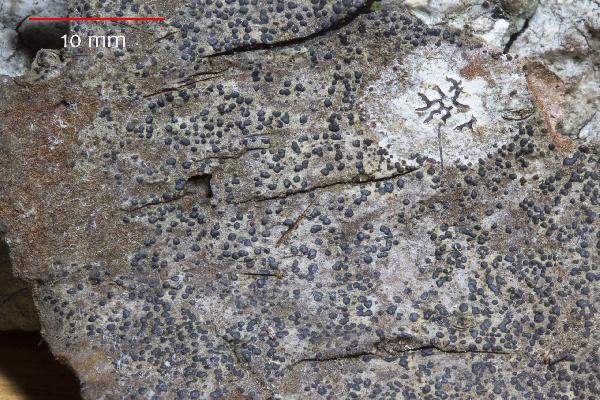
Marta Gonzalez Garcia - Centro de Estudios Micologicos Asturianos
Spain, Jardín Botánico Atlántico de Gijón (Asturias), 10-XI-2023, en corteza de Pinus sylvestris, leg. & det. M. González.
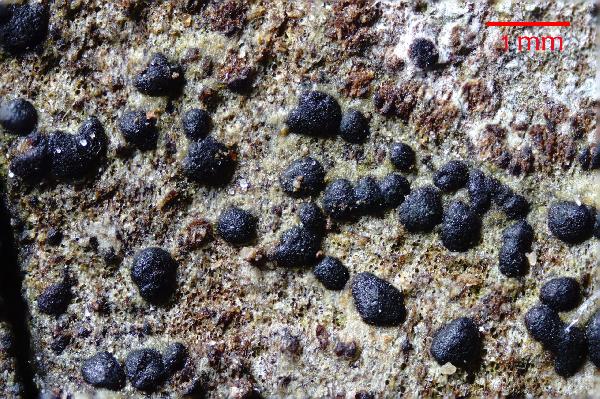
Marta Gonzalez Garcia - Centro de Estudios Micologicos Asturianos
Spain, Jardín Botánico Atlántico de Gijón (Asturias), 10-XI-2023, en corteza de Pinus sylvestris, leg. & det. M. González.
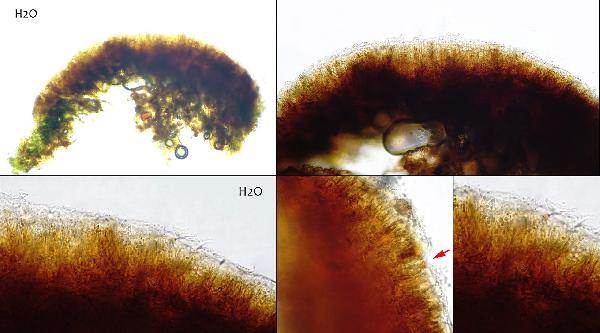
Marta Gonzalez Garcia - Centro de Estudios Micologicos Asturianos
Spain, Jardín Botánico Atlántico de Gijón (Asturias), 10-XI-2023, en corteza de Pinus sylvestris, leg. & det. M. González.
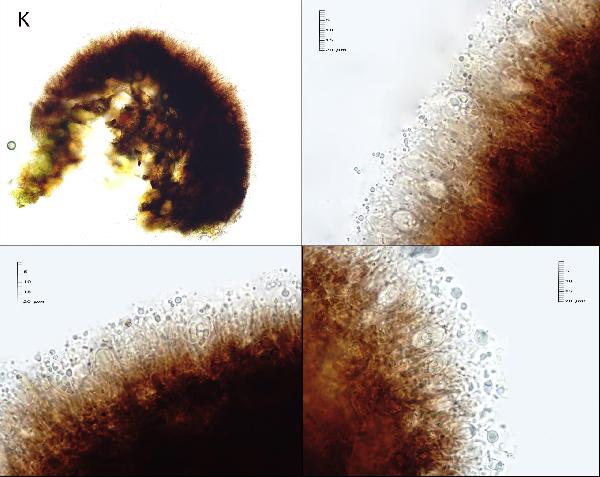
Marta Gonzalez Garcia - Centro de Estudios Micologicos Asturianos
Spain, Jardín Botánico Atlántico de Gijón (Asturias), 10-XI-2023, en corteza de Pinus sylvestris, leg. & det. M. González.

Marta Gonzalez Garcia - Centro de Estudios Micologicos Asturianos
Spain, Jardín Botánico Atlántico de Gijón (Asturias), 10-XI-2023, en corteza de Pinus sylvestris, leg. & det. M. González.
Growth form: Crustose
Substrata: bark
Photobiont: Trentepohlia
Reproductive strategy: mainly sexual
Most common in areas with a humid-warm climate (e.g. most of Tyrrenian Italy)
Commonnes-rarity: (info)
Alpine belt: absent
Subalpine belt: absent
Montane belt: rather rare
Dry submediterranean belt: extremely rare
Humid submediterranean belt: extremely rare
Padanian area: absent
pH of the substrata:
| 1 | 2 | 3 | 4 | 5 |
Solar irradiation:
| 1 | 2 | 3 | 4 | 5 |
Aridity:
| 1 | 2 | 3 | 4 | 5 |
Eutrophication:
| 1 | 2 | 3 | 4 | 5 |
Poleotolerance:
| 0 | 1 | 2 | 3 |
Altitudinal distribution:
| 1 | 2 | 3 | 4 | 5 | 6 |
Rarity
absent
extremely rare
very rare
rare
rather rare
rather common
common
very common
extremely common
Loading data...
Occurrence data
Predictive map

Felix Schumm – CC BY-SA 4.0
[14965], Germany, Baden-Württemberg, Kreis Tübingen, zwischen Dettenhausen und Bebenhausen, bei der Bärlochhütte im schattigen Buchenwald, 450 m

Felix Schumm – CC BY-SA 4.0
[19622], Germany, Baden-Württemberg, Kreis Göppingen, am Parkplatz nahe der Zachersmühle im Heiligenwald, auf Laubbaum, 48.75277° N, 9.61983° E, 364 m. Leg. et det. F. Schumm, 07.02.2017

Felix Schumm – CC BY-SA 4.0
[19622], Germany, Baden-Württemberg, Kreis Göppingen, am Parkplatz nahe der Zachersmühle im Heiligenwald, auf Laubbaum, 48.75277° N, 9.61983° E, 364 m. Leg. et det. F. Schumm, 07.02.2017

Felix Schumm – CC BY-SA 4.0
[19622], Germany, Baden-Württemberg, Kreis Göppingen, am Parkplatz nahe der Zachersmühle im Heiligenwald, auf Laubbaum, 48.75277° N, 9.61983° E, 364 m. Leg. et det. F. Schumm, 07.02.2017

Redinger, K. (1938) Arthoniaceae, Graphidaceae . In Kryptogamen-Flora von Deutschland, Österreich und der Schweiz. Band 9, 2 Abt., Part 1 (G. L. Rabenhorst, ed.): 181–404. Leipzig: Borntraeger

Zahlbruckner A. 1926. Lichenes (Flechten). In: Engler A. (ed.): Die natürlichen Pflanzenfamilien. 2nd ed., vol 8, W. Engelmann, Leipzig, 270 pp.

Felix Schumm – CC BY-SA 4.0
[14981], Germany, Baden-Württemberg, Kreis Göppingen, Marbachtal an Fagus, 350 m.

Courtesy Olivier Gonnet - Source: https://www.afl-lichenologie.fr/Photos_AFL/Photos_AFL_A/Textes_A2/Arthonia_didyma.htm
France, Session AFL 2014 - Parc de Mercantour

Courtesy Olivier Gonnet - Source: https://www.afl-lichenologie.fr/Photos_AFL/Photos_AFL_A/Textes_A2/Arthonia_didyma.htm
France, Session AFL 2014 - Parc de Mercantour

Courtesy Olivier Gonnet - Source: https://www.afl-lichenologie.fr/Photos_AFL/Photos_AFL_A/Textes_A2/Arthonia_didyma.htm
France, Session AFL 2014 - Parc de Mercantour

Courtesy Olivier Gonnet - Source: https://www.afl-lichenologie.fr/Photos_AFL/Photos_AFL_A/Textes_A2/Arthonia_didyma.htm
France, Session AFL 2014 - Parc de Mercantour

Jacques Haine - Source: http://www.lichensmaritimes.org/index.php?task=fiche&lichen=395&lang=en
France, Argonne

Bernard Bouffinet - Source: http://www.lichensmaritimes.org/index.php?task=fiche&lichen=395&lang=en
France, Cranou

Bernard Bouffinet - Source: http://www.lichensmaritimes.org/index.php?task=fiche&lichen=395&lang=en
France, Cranou

Jacques Haine - Source: http://www.lichensmaritimes.org/index.php?task=fiche&lichen=395&lang=en
France, Argonne

Jacques Haine - Source: http://www.lichensmaritimes.org/index.php?task=fiche&lichen=395&lang=en
France, Argonne

Ulrich Kirschbaum CC BY-SA 4.0 - Source: https://www.thm.de/lse/ulrich-kirschbaum/flechtenbilder
On smooth bark of deciduous trees.Central Europe: Germany.

Marta Gonzalez Garcia - Centro de Estudios Micologicos Asturianos
Spain, Jardín Botánico Atlántico de Gijón (Asturias), 10-XI-2023, en corteza de Pinus sylvestris, leg. & det. M. González.

Marta Gonzalez Garcia - Centro de Estudios Micologicos Asturianos
Spain, Jardín Botánico Atlántico de Gijón (Asturias), 10-XI-2023, en corteza de Pinus sylvestris, leg. & det. M. González.

Marta Gonzalez Garcia - Centro de Estudios Micologicos Asturianos
Spain, Jardín Botánico Atlántico de Gijón (Asturias), 10-XI-2023, en corteza de Pinus sylvestris, leg. & det. M. González.

Marta Gonzalez Garcia - Centro de Estudios Micologicos Asturianos
Spain, Jardín Botánico Atlántico de Gijón (Asturias), 10-XI-2023, en corteza de Pinus sylvestris, leg. & det. M. González.










